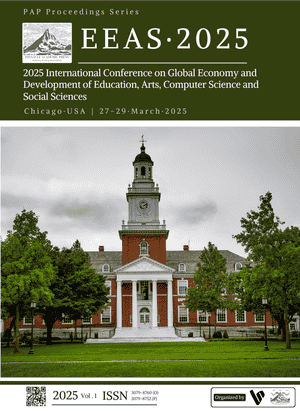China-ASEAN Relations in the South China Sea Dispute: Development Prospects and Paths for Cooperation
DOI:
https://doi.org/10.71222/2fjpr085Keywords:
China-ASEAN relations, South China Sea, regional cooperation, multilateral securityAbstract
The South China Sea issue continues to pose a major challenge in the realm of international affairs, particularly affecting relations between China and ASEAN member states. This article delves into the intricate geopolitical environment of the region, assessing the interplay between China and ASEAN within the context of ongoing tensions. While their strategic interests often diverge, both parties have achieved meaningful progress in enhancing economic partnerships and security cooperation. The paper investigates possible models for collaboration, emphasizing the significance of structured dialogue platforms such as the Code of Conduct (COC) discussions and broader multilateral security initiatives. Additionally, it highlights emerging avenues for economic engagement through projects like the Belt and Road Initiative (BRI) and the China-ASEAN Free Trade Area. Ultimately, the study suggests a constructive route for developing a stable framework for regional collaboration, aiming to facilitate a peaceful settlement of disputes. Through strengthened cooperation and mutual understanding, China and ASEAN have the potential to shift the South China Sea from a zone of contention to an example of harmonious coexistence.
References
1. H. K. T. Nguyen, "Mapping a decade of disputant and non-disputant behaviors in the South China Sea dispute," Mar. Policy, vol. 165, pp. 106189, 2024, doi: 10.1016/j.marpol.2024.106189.
2. M. Ortuoste, "Cascading risks in a social-ecological system: the South China Sea disputes," Third World Q., vol. 45, no. 14, pp. 2088–2107, 2024, doi: 10.1080/01436597.2024.2357658.
3. M. F. Karim, A. M. Rahman, and S. Suwarno, "Assessing the China threat: Perspectives of university students in Jakarta on the South China Sea dispute and the Belt and Road Initiative," Chin. Polit. Sci. Rev., pp. 1–25, 2024, doi: 10.1007/s41111-024-00251-5.
4. J. F. Bradford and R. Emmers, "Why the Quad is not squaring off in the South China Sea: Evaluating interests, objectives and capacity," Aust. J. Int. Aff., vol. 78, no. 1, pp. 1–21, 2024, doi: 10.1080/10357718.2024.2302908.
5. Y. C. Chang, X. Duan, and L. Yang, "The legal basis for Chinese vessels navigating in the South China Sea," Mar. Policy, vol. 165, pp. 106229, 2024, doi: 10.1016/j.marpol.2024.106229.
6. Z. F. Erkan, "The South China Sea disputes: International law," in Geopolitics of the South China Sea: Power Struggle in Asia, IGI Global Sci. Publ., 2025, pp. 191–220. ISBN: 9789004696341.
7. X. Chen, X. Zhang, and Q. Xu, "The implications of the Indo-Pacific Partnership for Maritime Domain Awareness (IPMDA) in the South China Sea: A Chinese perspective," Mar. Policy, vol. 167, pp. 106247, 2024, doi: 10.1016/j.marpol.2024.106247.
8. B. A. Putra, "Malaysia’s 'Triadic Maritime Diplomacy' strategy in the South China Sea," All Azimuth: J. Foreign Policy Peace, vol. 13, no. 2, pp. 166–192, 2024, doi: 10.20991/allazimuth.1455442.
9. Y. Yang and Y. Zou, "Development and national security: Indonesia’s Natuna Island and the South China Sea issue," Third World Q., vol. 45, no. 3, pp. 493–512, 2024, doi: 10.1080/01436597.2023.2270507.
10. B. A. Putra, "Brunei’s silent claims in the South China Sea: A case for the theory of trade expectations," Cogent Social Sciences, vol. 10, no. 1, pp. 2317533, 2024. ISBN: 9780262516600.
11. A. C. Nguyễn, M. T. Phạm, V. H. Nguyễn, and B. H. Trần, "Explaining the increase of China’s power in the South China Sea through international relation theories," Cogent Arts Humanit., vol. 11, no. 1, pp. 2383107, 2024, doi: 10.1080/23311983.2024.2383107.
12. L. Wijaya, "Navigating the roles of primary definers in the South China Sea conflict," Int. Commun. Gaz., pp. 17480485241309080, 2025, doi: 10.1177/17480485241309080.
13. Z. Paikin, "Multipolar competition and the rules-based order: Probing the limits of EU foreign and security policy in the South China Sea," Int. Spect., vol. 59, no. 1, pp. 161–178, 2024. ISBN: 9780434659159.
14. S. Yıldırım, "The South China Sea politics of the Philippines," in Geopolitics of the South China Sea: Power Struggle in Asia, IGI Global Sci. Publ., 2025, pp. 221. ISBN: 9789004696341.
15. E. Syailendra, "Malaysia's strategic approach: Unpacking the 'action-reaction spiral' logic in the South China Sea," Asian Polit. Policy, vol. 16, no. 3, pp. 357–376, 2024, doi: 10.1111/aspp.12751.
16. H. B. Cho and B. C. Chao, "Muddied waters: Freedom-of-navigation operations as signals in the South China Sea," Br. J. Polit. Int. Relat., vol. 27, no. 1, pp. 154–178, 2025, doi: 10.1177/13691481241257807.
17. C. Tamer, "Australia's policy in the South China Sea," in Geopolitics of the South China Sea: Power Struggle in Asia, IGI Global Sci. Publ., 2025, pp. 27–48. ISBN: 9789869282826.
18. F. Olorundami, "Joint development of petroleum resources in the East and South China Seas," in Int. Approaches Hydrocarbon Dev. Disputed Zones, Routledge, 2025, pp. 133–146. ISBN: 9781003491279.
Downloads
Published
Issue
Section
License
Copyright (c) 2025 Xingyi Ju (Author)

This work is licensed under a Creative Commons Attribution 4.0 International License.



